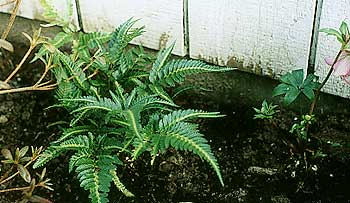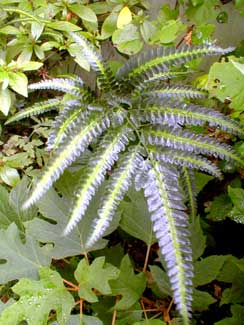 Variegated Shield Fern
Variegated Shield Fern
"For a moment I could see nothing
but the waving summits of the
ferns & reeds."
-The Island of Doctor Moreau
by H. G. Wells
by H. G. Wells
The Variegated Shield Fern (Arachnoides simplicior 'Variegata') is also known as Variegated East Indian Holly Fern. It is called a Holly Fern because like holly it is stiff-leaved & strongly evergreen. Ferns of the Cyrtomium genus are also called Holly Ferns, & they have evergreen leaves that actually look a bit like holly. So I prefer the name Variegated Shield Fern for this one, since it does not resemble holly.
It's a fairly cold-hardy fern native to China, Japan & India. It can grow to nearly three feet height though usually under two feet. Our first one was only about eleven inches tall when planted in 2002.
 It is shown in the first photo at the start of its second year in the garden, January 2003. As you can tell from that first portrait, it has remained evergreen throughout the winter in a sheltered corridor.
It is shown in the first photo at the start of its second year in the garden, January 2003. As you can tell from that first portrait, it has remained evergreen throughout the winter in a sheltered corridor.It keeps its beauty year-round in temperate to semi-tropical gardens, but will be semi-evergreen in colder regions & not look so great by the end of winter. It grows more slowly than most of the other ferns, & new foliage emerges later in spring than do most of the ferns. Yet by 2004 it had more than doubled in size.
I had gotten this first specimen as a small inexpensive plant in a "mixed" batch of ferns not realizing how excellent it would become. I soon after began looking for more of them, but it was not until autumn 2004 that one of the better local nurseries got them in for a very high price, so I could only afford one more which was planted near the birdbath, a location where it will be much more central a feature than the first one has been.
I presume they're not offered every year because of their slow rate of growth, as otherwise this fern's physical beauty ought to render them a priority item for growers & a first-choice among gardeners.
Though loving shade the same as all ferns, it does not suffer with slightly more morning sun than most would tolerate, & it survives droughtier conditions if it has to. But it would have a harder time at life if placed in afternoon sun.
Obviously loamy moist acidic soil is best, but it's nice to know it will tolerate less than perfect conditions. Ours peeps out from behind the shelter of a compact azalea hybrid, & is in rather deeper shade than is necessary. One large leaf is shown the second photo (taken in August 2004), poking out from the thick foliage of two shrubs that two years earlier did not hide quite so much of the fern.
Its main feature of delight, setting it apart from all other ferns, is the yellow stripe down the midrib of each glossy sea-green pinnule. This makes it one of the most strikingly colored of all ferns!
Some reports insinuate it is a little hard to grow, but in our garden it has been hardy as can be. It is probably tender at the extremes of its zone tolerances, but dead center in Zone 8 it is one of the hardiest ferns.